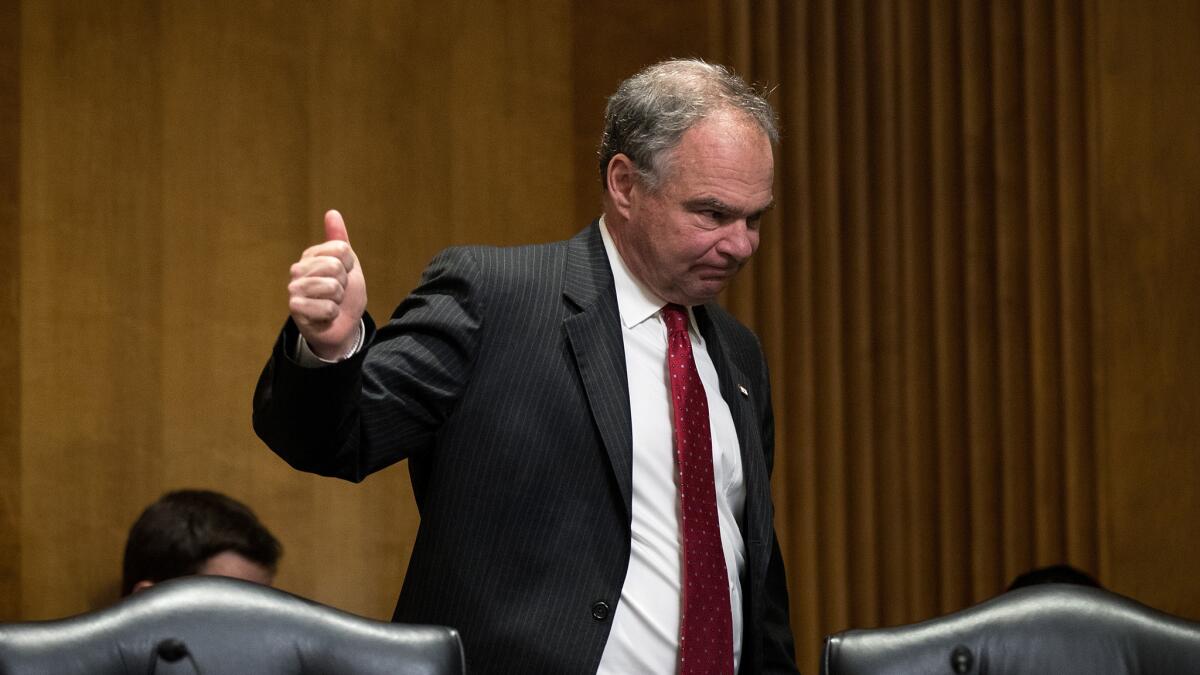How Tim Kaine went from ‘wild card’ vice presidential pick to shortlist favorite for Hillary Clinton

Reviewing the finalists to be his running mate in 2008, Barack Obama offered this assessment of then-Virginia Gov. Tim Kaine: “He’s the wild card.”
Now, as Hillary Clinton whittles down her potential vice presidential picks, Kaine has moved from what he once called the “long shot on a short list” to perhaps the safest, most obvious choice.
Whether the Virginia senator will end up on the Democratic ticket is a decision for Clinton and her advisors vetting candidates, said to include fellow Sens. Elizabeth Warren of Massachusetts and Sherrod Brown of Ohio, and Secretary of Housing and Urban Development Julian Castro. She will name her pick ahead of the Democratic National Convention late this month.
Kaine’s long resume is one of the chief reasons he has emerged as a heavy favorite for the nod, particularly as Clinton herself campaigns increasingly as a candidate who promises to govern with a steady hand. On NBC’s “Meet The Press” last week, an appearance facilitated by the Clinton campaign, Kaine offered a quick summary of his experience: mayor of Virginia’s capital of Richmond, its lieutenant governor, governor, Democratic Party chairman and now U.S. senator.
Election 2016 | Live coverage on Trail Guide | Sign up for the newsletter
But, he added, “I have got one job and one job only right now, and that is to work hard for Hillary Clinton.”
Kaine also represents a key swing state, as does Brown. But while Ohio has a Republican governor, Virginia’s Democratic incumbent, Terry McAuliffe, could ensure that Kaine’s Senate seat remained in the party’s control – no small consideration given that the party has made it a priority to recapture control of the chamber. McAuliffe, a longtime Clinton ally, is among the most public boosters of the idea of Kaine as her running mate, though there are others.
“He’s an excellent choice, and not just the safe choice, said former Pennsylvania Gov. Ed Rendell, who said Kaine would also meet the chief requirement for the office, readiness to serve as president.
“He’s a balanced candidate with experience in every one of the boxes you want a president to have some prior experience in,” added Rendell, who also served as DNC chairman at the end of Bill Clinton’s administration.
Kaine has yet to campaign with Clinton, as Warren and others have in rather public auditions that give the presumptive nominee a chance to evaluate their chemistry.
But if Clinton ultimately chooses Kaine, it will be the latest example of how well-executed political risks and good timing have played in his favor.
In February 2007, barely more than a year into his term as governor, Kaine became the first statewide elected Democrat outside Illinois to endorse Obama over Clinton, then the clear front-runner in the Democratic primary.
Obama had campaigned for Kaine, and the two Harvard Law School grads bonded over their mothers’ shared Kansas roots. In the 2008 race, Kaine admired Obama’s pragmatism and message of change, former aides say, and also believed that he represented the party’s best chance of turning Virginia, once reliably Republican, into a swing state.
As vice president, Kaine could have represented a doubling down on Obama’s change message, and he would’ve been a trusted ally in the White House, Obama campaign manager David Plouffe wrote in his book about the election, “The Audacity to Win.” But Obama and his advisors had concerns about Kaine’s lack of foreign policy experience, particularly with Obama himself facing questions about his readiness to be commander-in-chief.
“‘My sense is — and you tell me if the research backs this up — that Barack Hussein Obama is change enough for people,’” Obama said as he prepared to make a final decision, according to Plouffe’s account. “But I think people will grow to really respect and appreciate Tim Kaine. He’s the wild card.” Obama, of course, ultimately chose then-Sen. Joe Biden, long the leading candidate.
Kaine’s aspirations after leaving the governor’s mansion were not political, those close to him say. His ideal job was university president. But soon after he was elected president, Obama asked Kaine to serve as chairman of the Democratic National Committee, a role he would balance with his duties as governor for the final year of his term.
The experience connected him with a national network of donors as well as rank-and-file Democrats throughout the country. A former aide said he also made a point each week of speaking by phone with as many as a dozen volunteer organizers.
Kaine’s time at the party headquarters coincided with major electoral setbacks – the loss of his own seat and New Jersey’s governorship in 2009 and ultimately the 2010 tea party wave that swept Republicans into the House majority.
Early in 2011, another unexpected opportunity arose. First-term Democratic Sen. Jim Webb of Virginia surprised many by announcing he would not seek reelection. Obama was among those who quickly lobbied for Kaine to join the race.
After one of the most expensive Senate races of the cycle, Kaine would earn more votes in his victory over former Gov. George Allen than Obama did in carrying the state a second time.
Immediately after he arrived in the Senate, Kaine began to address the foreign policy shortcoming that Plouffe identified with two committee assignments he sought, on the armed services and foreign relations committees. He became a prominent voice calling for lawmakers to pass a new legislative mandate for using military force against the Islamic State, and at times was critical of the Obama administration’s approach to the Syrian civil war.
Kaine has proved to be a reliable Democratic vote on major issues. In 2013, he became the first senator to deliver an entire speech in Spanish, in support of bipartisan immigration reform legislation. Kaine learned the language while working with Jesuit missionaries in Honduras during a year off from law school, and his fluency would be an obvious asset on the campaign trail in appealing to Latino voters.
Kaine’s Catholic faith has, like the current vice president’s, been a major factor in his public life. Last fall he wiped away tears as he watched Pope Francis, the first Jesuit leader of the Roman Catholic Church, address a joint meeting of Congress. He won the governorship in 2005 despite his opposition to the death penalty, a major campaign issue. And while he said he considers himself personally anti-abortion, he has voted to protect abortion rights.
His personal view on abortion, and some instances of compromise with Republicans – he worked with a GOP legislature while he was governor – have been cited as potential strikes against him as a potential vice presidential pick, particularly as Clinton still faces resistance in her own party from supporters of Vermont Sen. Bernie Sanders, who might be quicker to cheer Warren as a running mate.
He also voted for legislation in 2015 that would help expedite consideration of the Trans Pacific Partnership trade pact, which is supported by President Obama but opposed by labor unions and progressive groups. Clinton has also said she doesn’t support the deal.
“He won’t be Elizabeth Warren,” Rendell acknowledged. “He won’t be as biting.”
But Kaine has demonstrated a commitment to social justice that presaged the demands that Sanders backers have made of Democrats, such as his early work as a fair housing lawyer, said Sen. Claire McCaskill (D-Mo.), like Kaine an outspoken Obama backer in ’08 who now serves the same role for Clinton.
“He has lived his life in a way that reflects those progressive values that I think that wing of our party is anxious to grab on to,” she said. “If they slow down long enough, if they get past a vote or two and look at who he is and how he’s lived, I think they’ll find a lot to like.”
Kaine has several attributes that could contribute to a campaign, McCaskill said, citing his ability to communicate, his policy knowledge, governing experience and even his optimism. While noting that some of her Senate colleagues are also potential vice presidential picks – “it’s like picking between my kids” – she added that Kaine would help project the image of Clinton that her campaign is pushing: the serious choice over the uncertainty they believe Donald Trump offers.
“If we’re going to have a grown-up team versus the crazy team,” McCaskill said, “he fits in nicely with the grown-ups.”
UPDATES:
12:51 p.m.: This article was updated with comments from former Pennsylvania Gov. Ed Rendell.
This article was originally published at 12:02 p.m.
More to Read
Get the L.A. Times Politics newsletter
Deeply reported insights into legislation, politics and policy from Sacramento, Washington and beyond. In your inbox three times per week.
You may occasionally receive promotional content from the Los Angeles Times.











